The best thermal imaging binoculars in 2025
The best thermal imaging binoculars let you spot wildlife and people in darkness or camouflaged using their heat signature
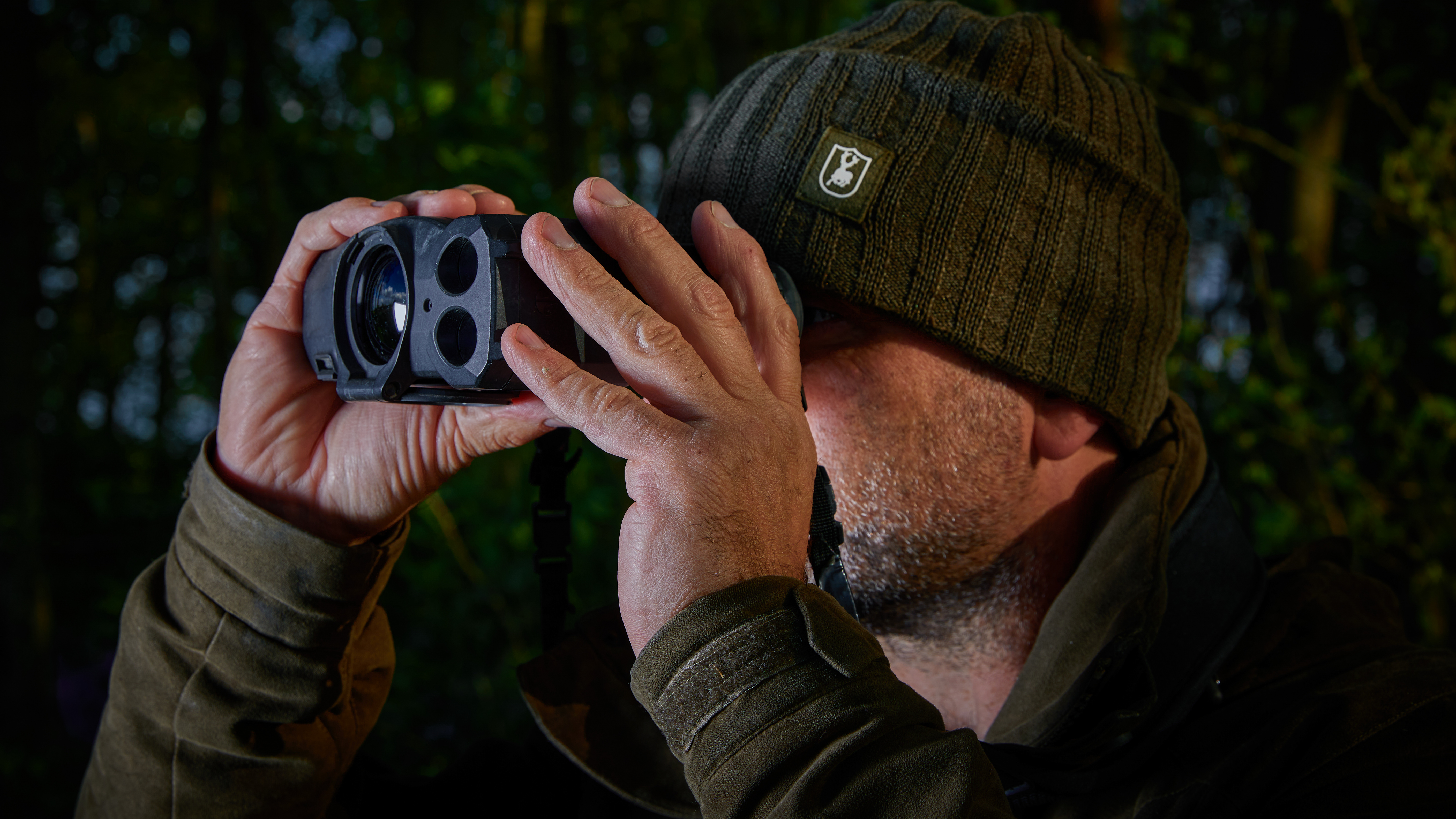
Looking for the best thermal-imaging binoculars? This guide will help you invest your money wisely, and help you track down the right price at the best available price.
As observational tools to draw the faraway closer, binoculars come in a range of shapes and sizes, yet there are a number of specialisms they fulfill. These include marine binoculars waterproofed and equipped with navigational aids, night-vision binoculars that provide that amplify available light for night viewing, or image-stabilized binoculars that avoid any visible wobble at maximum magnification without the need for a tripod.
Thermal imaging binoculars differ from night vision binoculars and goggles, in that thermal binoculars provide us not with a brighter view in the dim, but rather with the heat signature of our subject. Any avid viewer of nature documentaries will be aware, as seen through thermal-imaging cameras and thermal drones, colder parts of any living creature will typically appear blue, while warmer parts will appear yellow, orange, and red. In this way, we derive their heat ‘signature’. Thermal imaging binos are used for detecting and observing animals in in environments in which they might otherwise be obscured. They can also be used for surveillance and rescue - spotting people or vehicles.
Some thermal binoculars are multispectral devices - which combine a thermal camera with an optical one. This gives the best of both worlds, allowing them to observe things in normal vision, as well as a heat map.
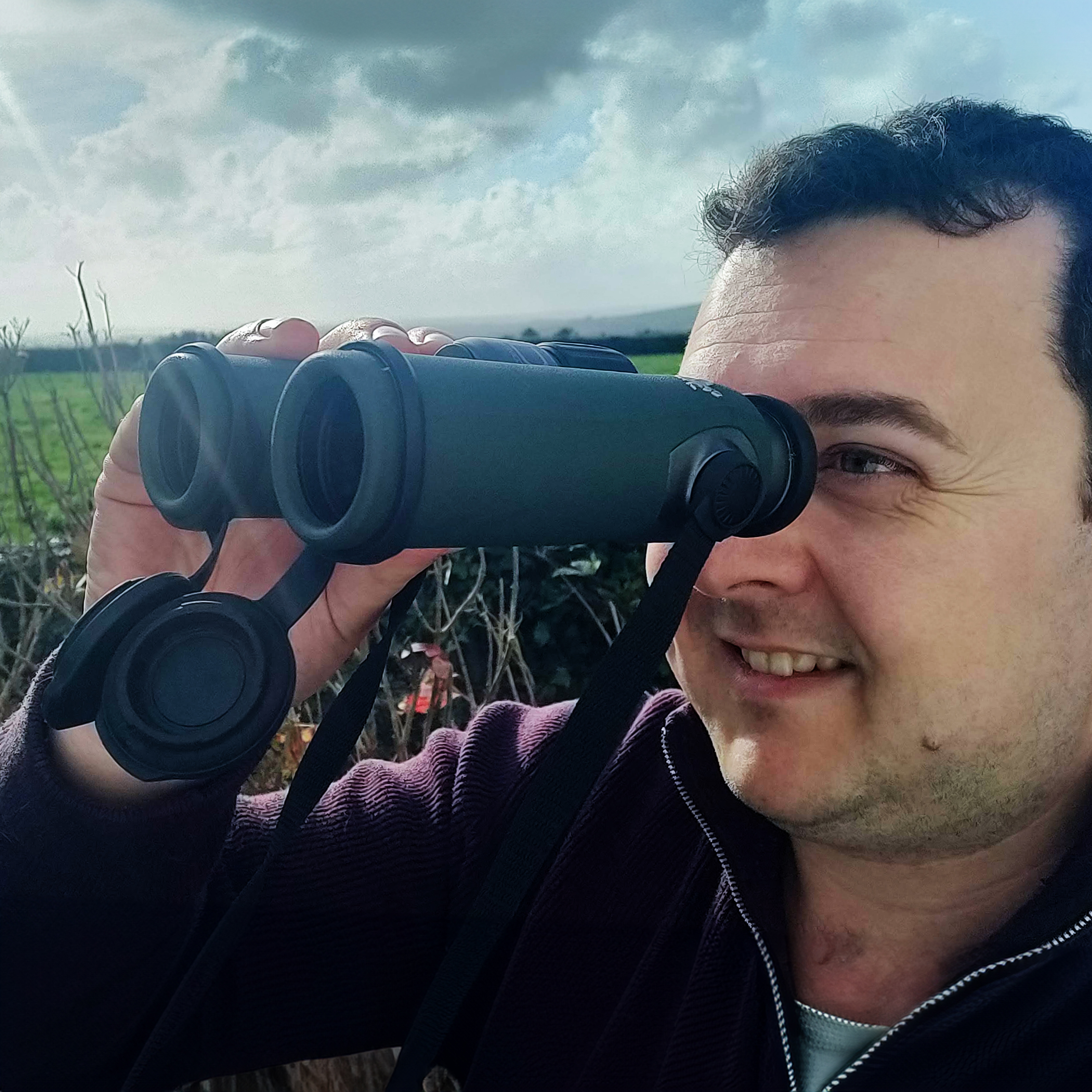
For nearly two decades Sebastian's photography has been published internationally. He is also a big country sportsman who can often be found in or around the shooting field, sailing on the open sea, or taking part in other country pursuits, and quite often has either a pair of binoculars, a monocular or a scope in his hand.
Best thermal binoculars: our top picks
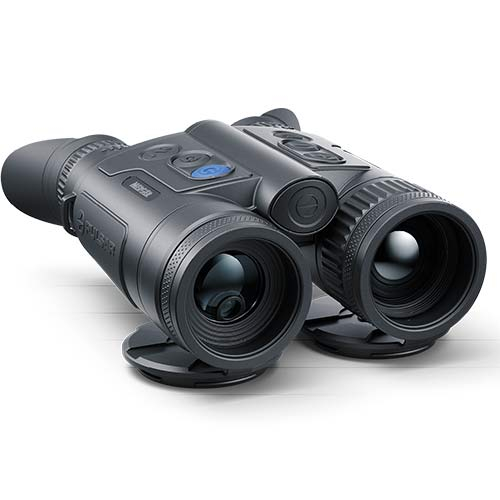
The Pulsar Merger LRF XP35 thermal imaging binoculars offer advanced thermal detection, a built-in laser rangefinder, and a rugged weatherproof design, ideal for outdoor and professional use. High cost, but premium performance.
Read more below
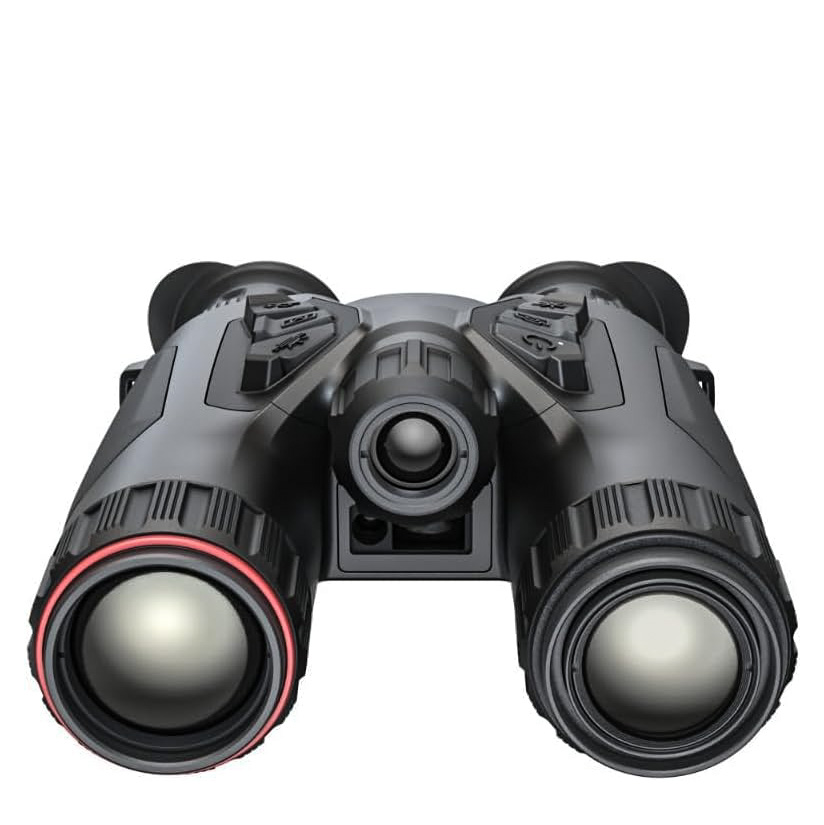
This innovative rugged pair of multi-spectrum binos has a normal camera in one lens and a thermal imager in the other. These are a great budget choice for daylight observations. These are sold under the AGM brand in North America
Read more below
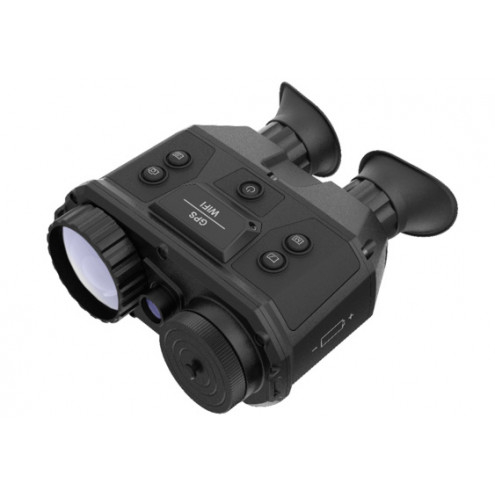
This mulitspectrum pair offers both a video and snapshot facility, the thermal imaging unit purports to provide different image palette variants, including white hot or black hot, which are adaptable depending on the environmental conditions at the time.
Read more below
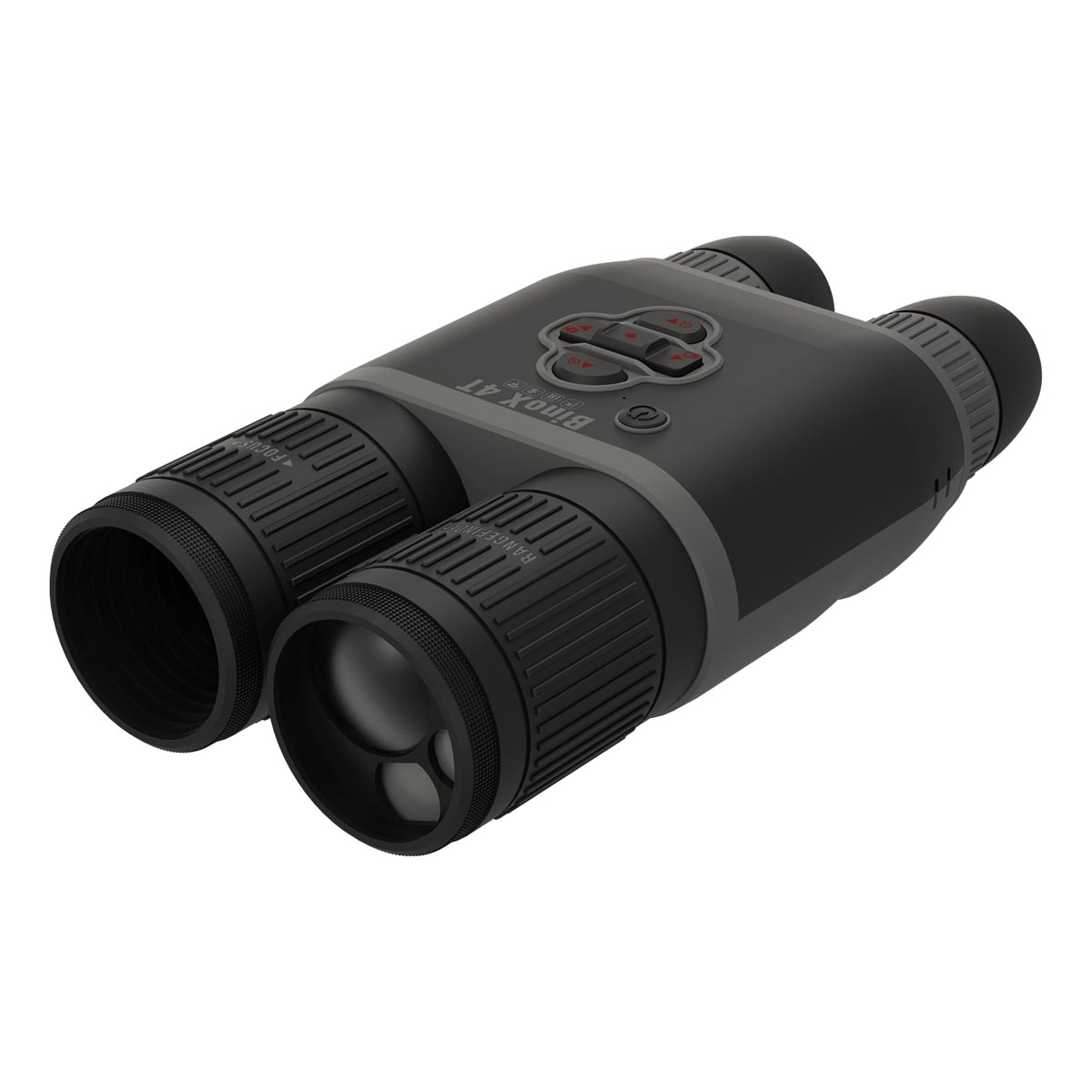
Promising 16 hours of active use and the ability to pick out creatures otherwise disguised by thick vegetation are these thermal binoculars, which – although a relatively pricey specialist tool offers cost-effective multi-purpose use.
Read more below
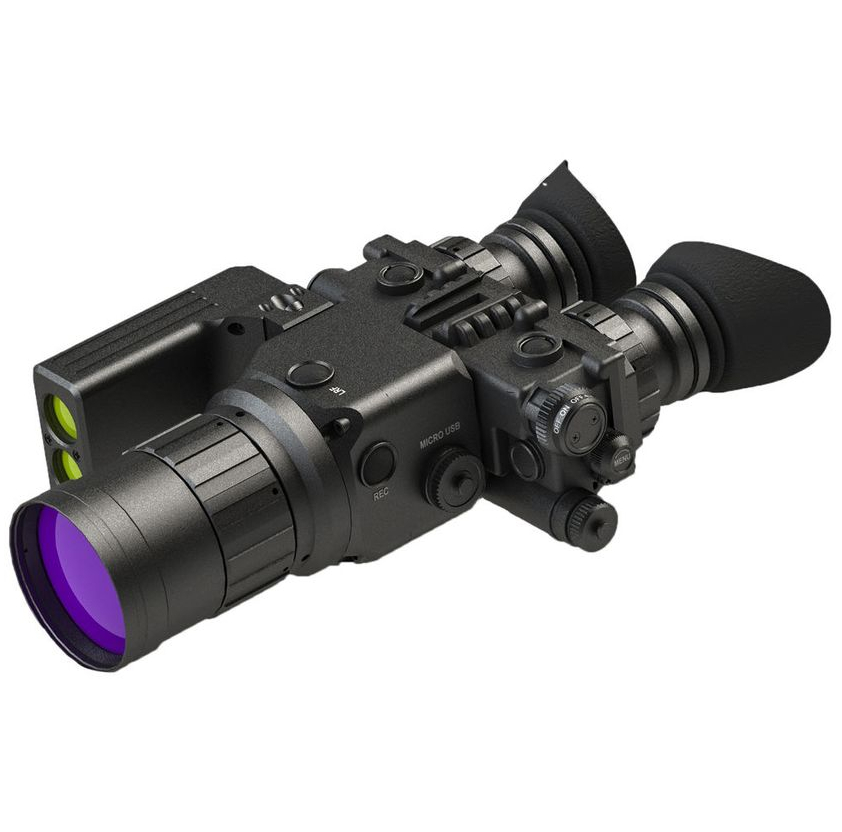
This thermal device features an unusualP biocular design with a detection range of 1,500 yards and a 384x288 sensor resolution, upscaled to 640x480. It offers ten color palettes, Wi-Fi streaming, 32GB of storage, and a 1024x678 OLED display.
Read more below
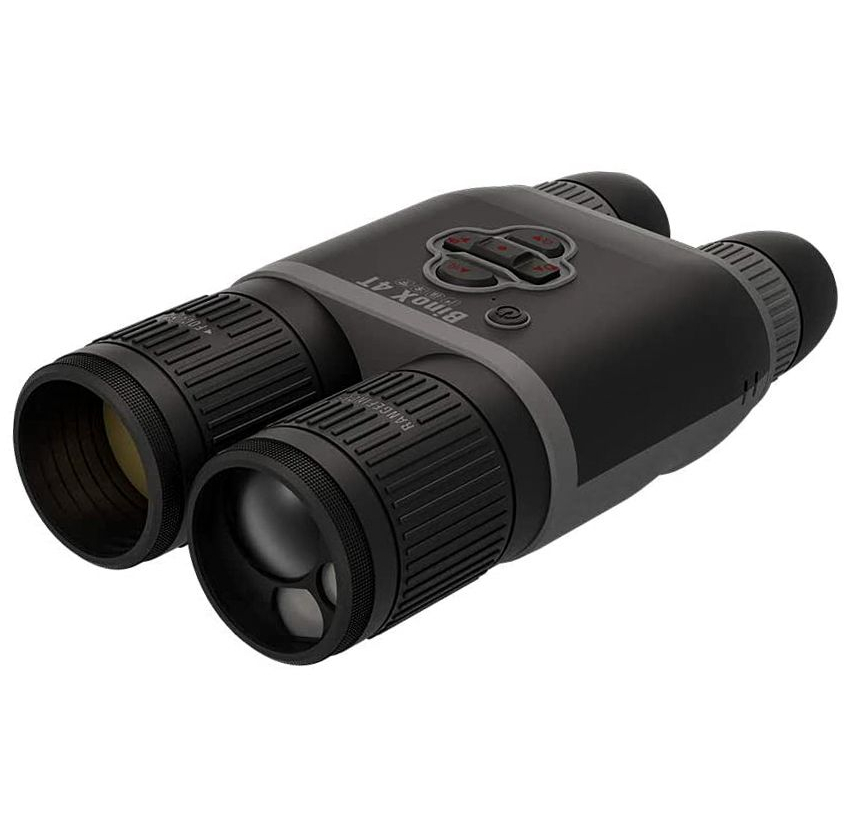
These offer a higher magnification range than the 2-8X model, enabling thermal detection up to 1,800m. Ideal for night use, it features a laser rangefinder, and captures 1280x960 video at 60 fps.
Read more below
Best thermal binoculars
Why you can trust Digital Camera World
Best overall
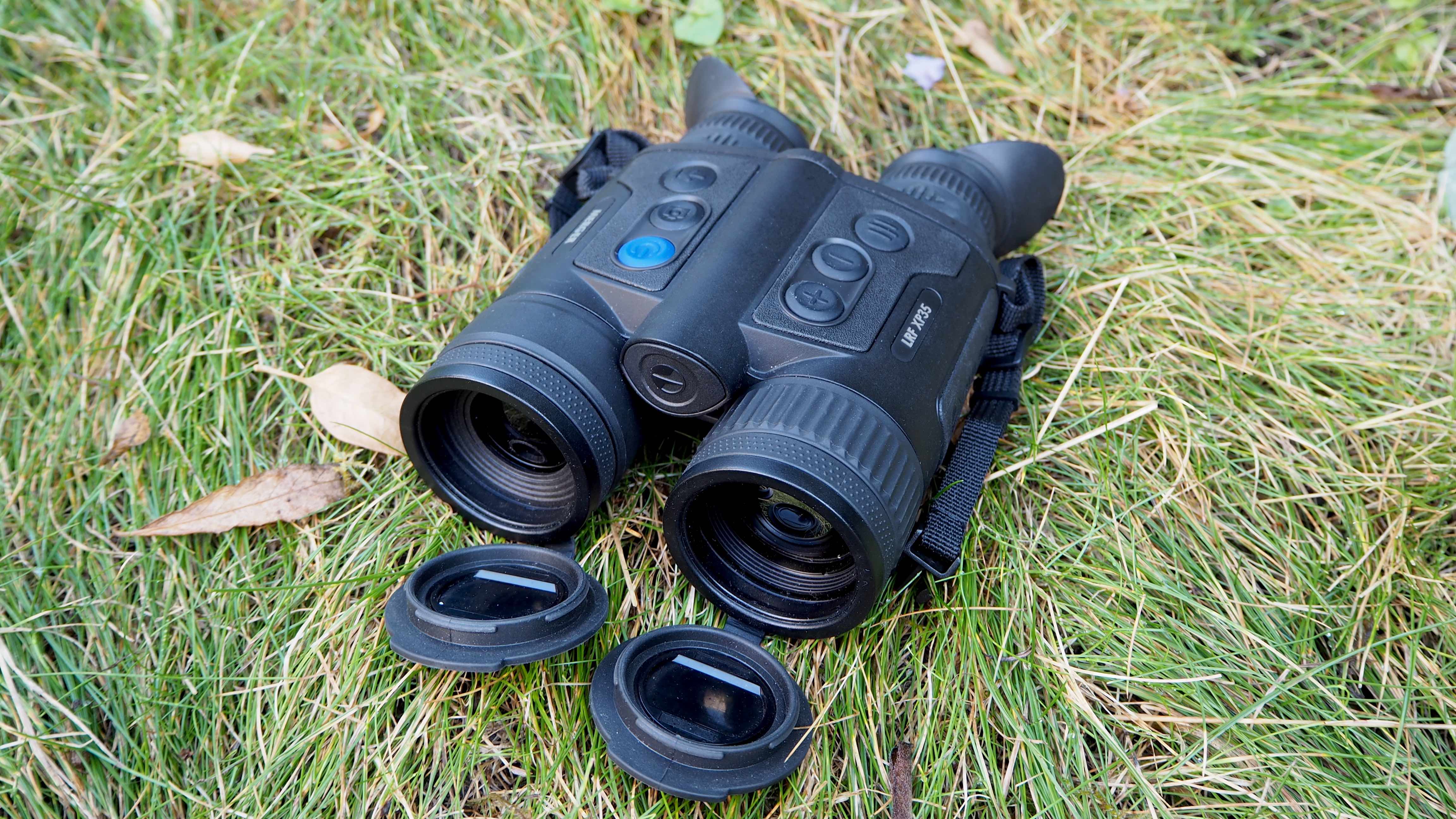
Specifications
Reasons to buy
Reasons to avoid
The Pulsar Merger LRF XP35 thermal imaging binoculars are highly regarded for their precision and range, making them a premium choice for outdoor enthusiasts, hunters, and security professionals. With its thermal imaging capabilities, users can detect heat sources at long distances, even in challenging environments. The built-in laser rangefinder enhances accuracy, giving users the ability to measure distances up to 1,000 meters.
In terms of build, the binoculars boast a compact, ergonomic design with easy-to-use controls. The 640x480 resolution display provides clear visuals, and the device offers multiple color palettes to adjust according to specific lighting conditions. Its weatherproof and durable build ensures it can handle tough conditions, whether in rain or extreme temperatures.
However, the Pulsar Merger LRF XP35 is a significant investment, and its high price might be a barrier for some buyers. Still, for those needing top-tier performance in thermal imaging, the device offers excellent quality and durability, making it a recommended option for serious users.
Read our Pulsar Merger LRF XP35 thermal imaging binoculars review for more details
Best budget thermal binoculars
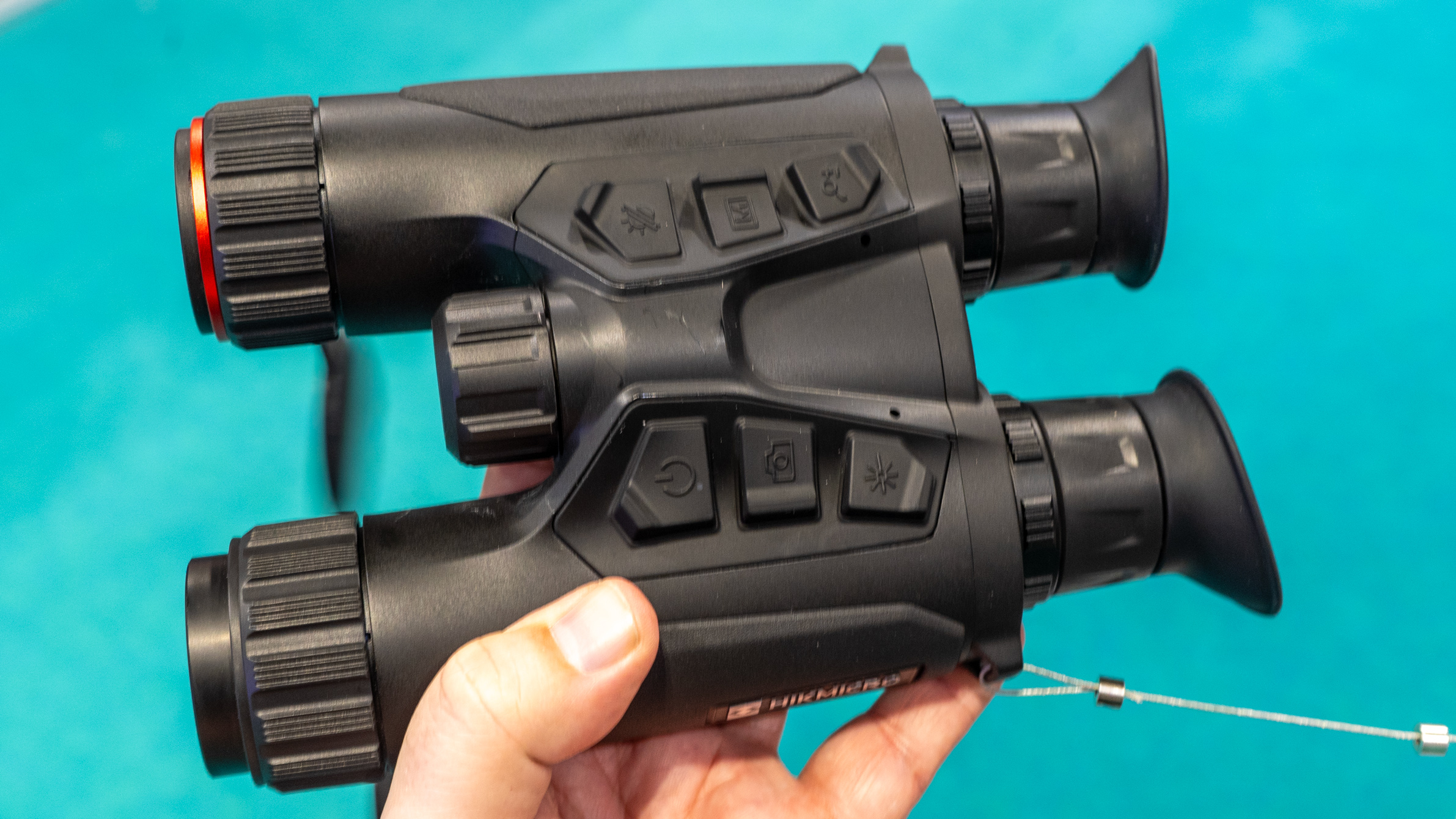
2. Hikmicro Habrok 4k HE25L
Specifications
Reasons to buy
Reasons to avoid
This budget Hikmicro was launched in 2024 and slashed the price of its predecessor by half. It looks like a traditional pair of binoculars but places a thermal camera in one lens and an optical one in the other, each with its own focusing ring. A press of a button on the top switches the views. These are sold as the AGM ObservIR LRF 25-256 in North America.
This budget model has a lower 256 × 192 thermal resolution than its more expensive predecessor, the HQ35L, which used the same rugged but offered a 640 x 512 thermal camera. The result is a thermal binocular that is ideal for daylight use... It's enough thermal resolution to find a bird or animal, then switch to the optical view to follow it and record detailed visuals, but at a fraction of the cost of models designed for nocturnal use.
The thermal display has a refresh rate of 50Hz, so it feels very natural when you view it – much more so than some devices I've tried in the past.
There is also a built-in 940 nm IR illuminator and a laser rangefinder measuring 1000m in distance, which is helpful for photographers assessing focus and tracking animals. The IP67-rated device can capture video at 4K, and store it on built-in 64GB of storage; files are offloaded via wireless tech.
Best for sharing
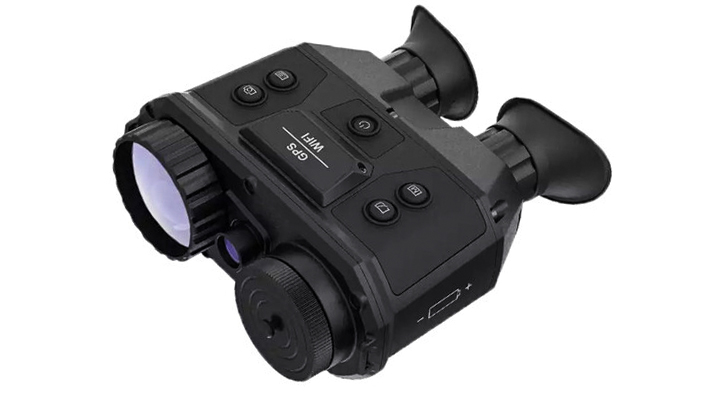
3. AGM Explorator FSB50-640
Specifications
Reasons to buy
Reasons to avoid
These handheld binoculars are packed with tech. They combine an ultra-low light optical detector with a 640x512 thermal detector, a 1024x768 OLED display, and an eyepiece offering a large field of view. The device can also pinpoint moving subjects even in fog, rain, smoke, and snow.
As expected then, the binos are waterproof to IP67 level and built to withstand more challenging weather conditions. We also get the ability to mount the binoculars on a tripod, thus allowing the viewer to enjoy hands-free use. Four rechargeable lithium-ion batteries are required for use, providing up to seven hours’ performance, which falls in the middle of the options showcased here for battery life.
With both a video and snapshot facility, the thermal imaging unit purports to provide different image palette variants, including white hot or black hot, which are adaptable depending on the environmental conditions at the time. Peace of mind is provided via a limited three-year warranty.
Best for battery life
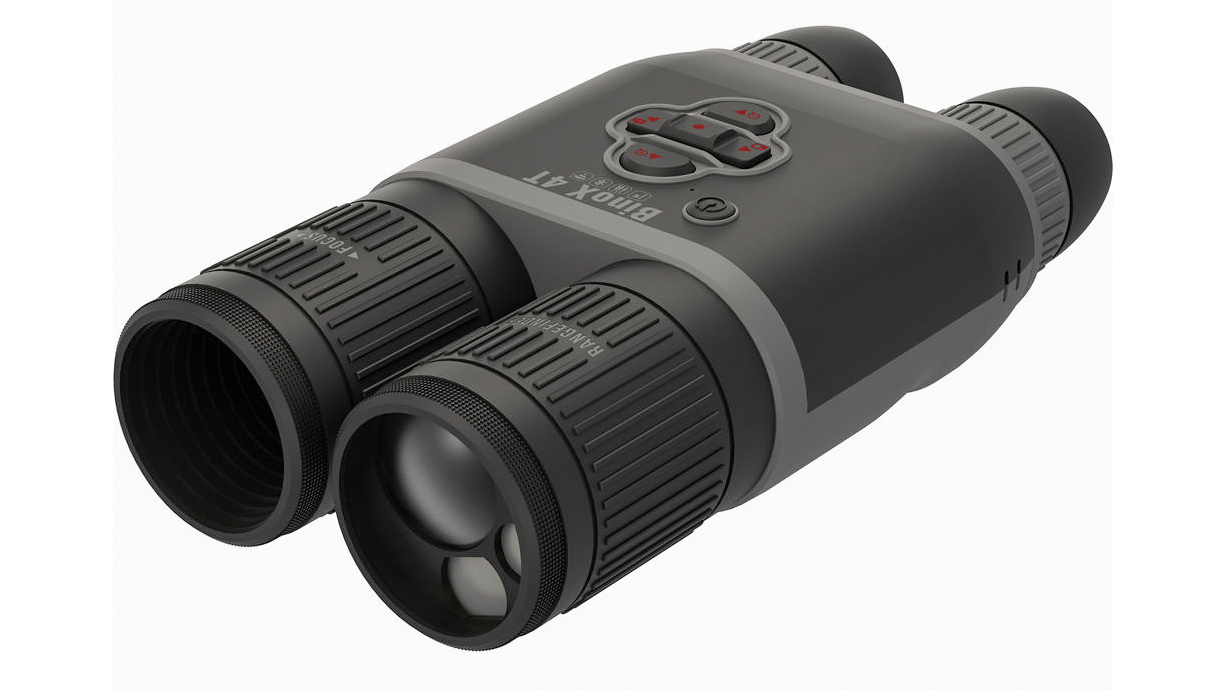
4. ATN BinoX 4T 384 2-8X Thermal Binoculars
Specifications
Reasons to buy
Reasons to avoid
Promising 16 hours of active use and the ability to pick out creatures otherwise disguised by thick vegetation are these thermal binoculars, which – although a relatively pricey specialist tool offers cost-effective multi-purpose use. A key benefit is that they can record Full HD video at 60fps stored on microSD card. We also usefully get a zoom function, as well as remote control via a smartphone app, thanks to onboard Wi-Fi.
A further promise is the ease of use, in that subjects can be acquired and distance gauged with just one button click. Featuring a fourth-generation thermal sensor, and pitched as being well suited to bird, wildlife, and nature observation, its manufacturer suggests that the built-in laser rangefinder can additionally be used for golfing and other sports.
Inter-pupillary distance is adjustable as is eye relief for viewing comfort, meaning that these weather-resistant binos can be shared around and used by different members of the family if desired. Other handy features include an electronic barometer and compass. A lithium-ion battery is required for use; thankfully this is included in the package.
Best premium option
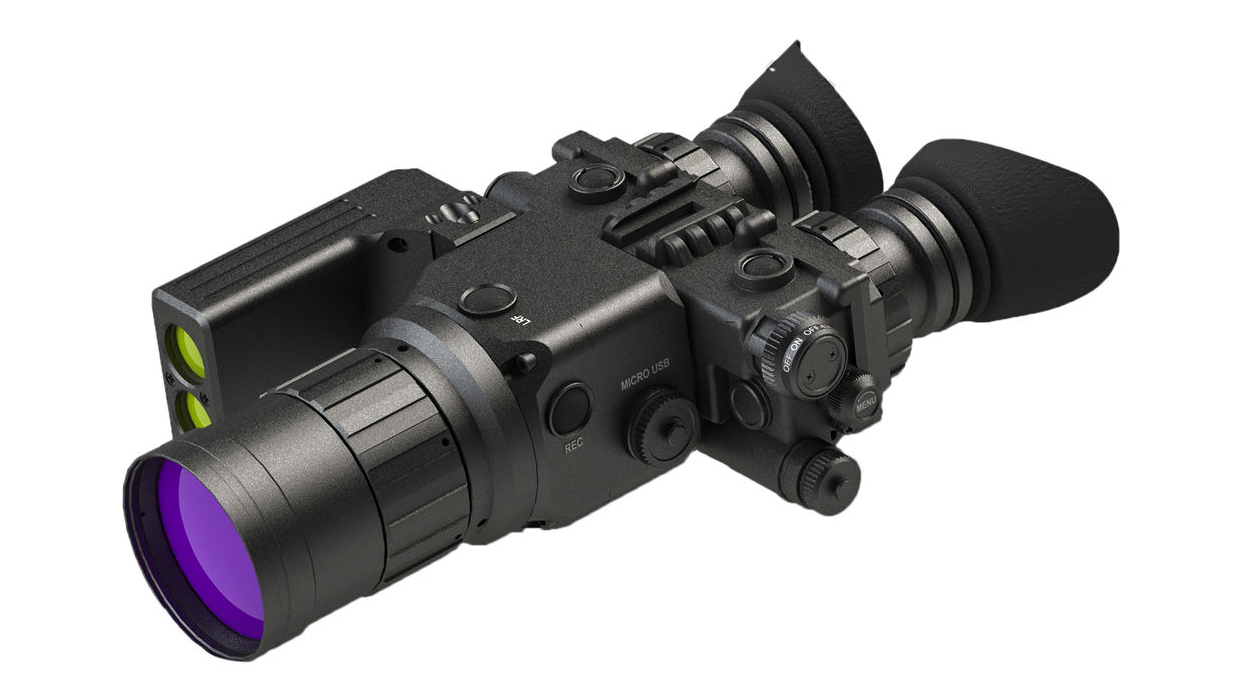
5. Luna Optics D-55 Genesis Dominus biocular
Specifications
Reasons to buy
Reasons to avoid
Resembling a laser-emitting Star Wars gizmo, this one costs almost as much as one might bid for such a movie prop in a charity auction, yet has a Latin word in its title to further signify the seriousness of its intent. This uses a biocular design, rather than a binocular one - so the eyepieces share the same front objective lens assembly. On the plus side, we get a maximum detection range of an impressive 1500 yards, while its integral sensor’s native resolution of a modest – yet fairly standard for this market – 384x288 pixels can be boosted to 640x480.
In terms of the view provided, there are ten color palettes to choose from, while battery life, provided via a pair of CR123 cells, is good for a so-so two to three hours. The device is also IPX5-rated splash-proof, plus displays distance in yards or meters.
For those looking to capture video, we’re gifted the ability for streaming via Wi-Fi to a device running the specific ‘VLC’ app, while there is 32GB of internal storage for recording footage. Rounding off the package is a 1024x678 micro OLED display. If the spec here isn’t quite enough for you, there is also a slightly higher-up D-80 model that extends the magnification from 6-24x and provides an 80mm lens, as opposed to the still very useful 50mm objective lens of this iteration.
Best for zoom
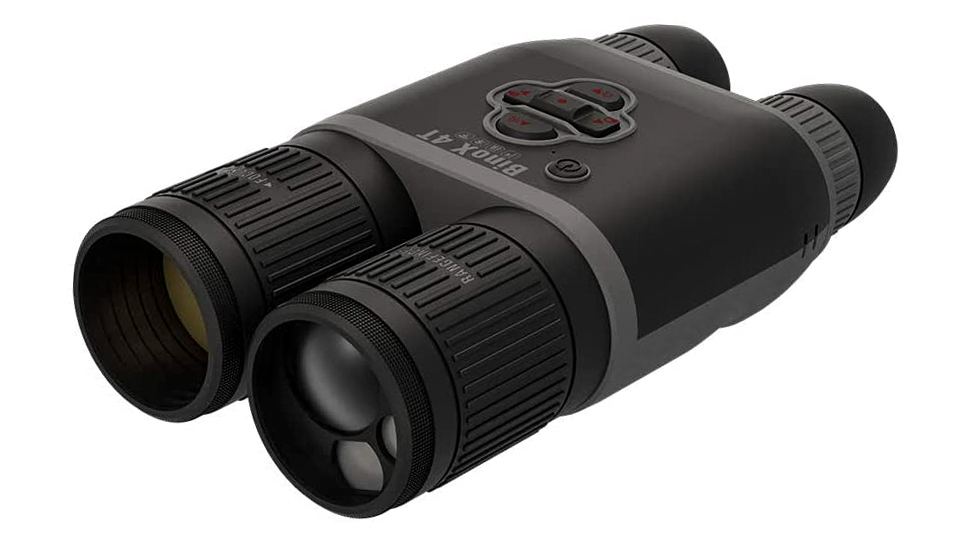
6. ATN BinoX 4T 384 4.5-18X Thermal Binoculars
Specifications
Reasons to buy
Reasons to avoid
The ATN BinoX 4T 384 4.5-18X binoculars look exactly the same as the ATN BinoX 4T 384 2-8X - and share the same set of impressive features. But the big difference is in the magnification range which offers you the potential of seeing much further into the distance, with a much narrower angle of view.
This could be particularly useful when using thermal imaging at night - allowing you to detect the presence of a human body at up to 1800m (as opposed to just 920m with the 2-8X version). The range for human recognition or identification is not as great, of course, but the workable range is still significantly enhanced with the great magnification.
The core features still include a laser rangefinder, and the ability to record 1280x960-pixel video at 60 fps - which can be saved on a memory card and transferred to a smartphone via Bluetooth.
Best for video

7. Pulsar Accolade LRF XP50 Pro
Specifications
Reasons to buy
Reasons to avoid
Fitted with a 640x480 thermal sensor, frost-resisting OLED display, and boasting a generous 1800-meter detection range plus 13-hour battery life, the specification here is, in part, a cut above the norm for a device of its ilk. That said, the native magnification is a fairly modest 2.5x, even if this can be combined with an 8x digital zoom to offer the total equivalent of 20x.
Like competing devices here, there is the ability to capture videos, along with photos in this particular case, both of which are written to the 16GB internal memory. The provided battery here is good for a robust 13 hours of use and can be recharged via a standalone charger or using the USB port, while there’s also a laser rangefinder to help users pinpoint subjects, with a 1000 meter, plus a Stream Vision app to connect these binos to a smart device. It all adds up to another comprehensive package for those requiring a thermal imaging component to their observations, even if the price tag is equivalent to sending a family of four to Seychelles for a fortnight, no thermals required.
Thermal binoculars: what to look for
Like with any other binoculars, what we want to be looking for amongst the specification is the magnification provided. Thermal binoculars obviously also comprise thermal sensors, so we might also want to take a cursory glance at the thermal resolution of said sensor and, as we’re destined to be using binoculars outdoors in the main, also its operating temperature if given and detection range.
The detection range is related to the resolution of the thermal sensor; the higher the resolution, the further it can detect. Generally speaking, because we’re looking to pick out and identify subjects that we might not be able to spot with the naked eye if viewing at night, thermal binoculars offer a wide or large field of view, so as to give us a better opportunity for observation.
Because these are very much specialist tools, tracking down these thermal imaging products may be less easy than finding your common-or-garden optical binocular, while choice and popularity seem to be greater in the USA than elsewhere. But, thanks to the Internet, we live in a global market, so snagging your thermal imaging binoculars of choice is often only a few clicks away…
Get the Digital Camera World Newsletter
The best camera deals, reviews, product advice, and unmissable photography news, direct to your inbox!
Gavin has over 30 years’ experience of writing about photography and television. He is currently the editor of British Photographic Industry News, and previously served as editor of Which Digital Camera and deputy editor of Total Digital Photography.
He has also written for a wide range of publications including T3, BBC Focus, Empire, NME, Radio Times, MacWorld, Computer Active, What Digital Camera and the Rough Guide books.
With his wealth of knowledge, Gavin is well placed to recognize great camera deals and recommend the best products in Digital Camera World’s buying guides. He also writes on a number of specialist subjects including binoculars and monoculars, spotting scopes, microscopes, trail cameras, action cameras, body cameras, filters and cameras straps.

